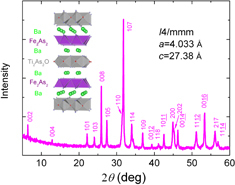Abstract
Single crystals of a new iron-based superconductor Ba2Ti2Fe2As4O have been grown successfully via a Ba2As3-flux method in a sealed evacuated quartz tube. Bulk superconductivity with Tc ∼ 21.5 K was demonstrated in resistivity and magnetic susceptibility measurements after the as-grown crystals were annealed at 500 °C in vacuum for a week. X-ray diffraction patterns confirm that the annealed and the as-grown crystals possess the identical crystallographic structure of Ba2Ti2Fe2As4O. Energy-dispersive x-ray spectra indicate that partial Ti/Fe substitution exists in the [Fe2As2] layers and the annealing process redistributes the Ti within the Fe-plane. The ordered Fe-plane stabilized by annealing exhibits superconductivity with magnetic vortex pinned by Ti.
1. Introduction
Since high-temperature superconductivity was reported in iron pnictides in 2008 [Citation1], great efforts have been made to explore new iron-based superconductors. So far, several crystallographic types of iron-based superconductors have been discovered. They include REFeAsO (RE = rare earth, ‘1111’) [Citation1], AFeAs (A = Li, Na or K, ‘111’) [Citation2], AEFe2As2 (AE = Ca, Sr, Ba or Eu, ‘122’) [Citation3, Citation4] and FeX (X = Se or Te, ‘11’) [Citation5] systems. Among them, the ‘122’ system has attracted the most interest because it yields sizable single crystals [Citation6–Citation9], which makes it possible to investigate intrinsic physical properties and to understand the superconducting mechanism of iron-based superconductors.
Recently, our group designed and successfully synthesized a new iron-based superconductor Ba2Ti2Fe2As4O with Tc ∼ 21.5 K [Citation10]. This compound contains not only the same [Fe2As2] layer as in other iron-based superconductors, but also another conducting sheet [Ti2O], which makes it very distinctive. First-principles studies suggest that the intercalated [Ti2O] layers, with a possible charge/spin-density wave (CDW/SDW) ordering, transfer 0.12e charge to the [Fe2As2] layers, which causes superconductivity in the [Fe2As2] layers without explicit doping [Citation11]. Later, a series of compounds with superconductivity originating from the [Ti2O] sheets were reported [Citation12–Citation14]. So, the coupling between the [Fe2As2] layers and the [Ti2O] sheets in Ba2Ti2Fe2As4O, both being possibly superconducting, is an intriguing issue. This calls for more experimental studies of the intrinsic physical properties, which requires the growth of Ba2Ti2Fe2As4O single crystals.
An FeAs-flux method [Citation7–Citation9] is efficient for growing oxygen-free crystals, such as those of the ‘122’ system, but not for oxypnictides such as Ba2Ti2Fe2As4O. Recently, by employing a NaAs-flux method, the ‘1111’ oxypnictides were successfully grown [Citation15, Citation16]. To avoid introducing extra elements, Ba2As3 was chosen as the flux for growing Ba2Ti2Fe2As4O single crystals, since it has been used to grow sizable single crystals of doped BaFe2As2 [Citation17]. In this paper, we report a successful trial to grow Ba2Ti2Fe2As4O single crystals. By annealing the crystals for a week, we obtained crystals with bulk superconductivity at 21.5 K. The as-grown and annealed crystals were both studied through x-ray diffraction (XRD) and energy dispersive x-ray spectroscopy (EDS) analysis, and we conclude that superconductivity is influenced by the level of Ti/Fe substitution in [Fe2As2] layers.
2. Experimental details
The flux, with nominal compositions of Ba2As3, was prepared by reacting Ba and As (Alfa Aesar, 99.9%) in a sealed quartz tube, which was then heated to 700 °C at a rate of 30 °C h−1 and held for 10 h. This precursor was mixed with some other starting materials (Alfa Aesar) at a molar ratio of TiO2 ( 99.9%):Ti (dehydrided, 99.99%):Fe ( 99.5%):Ba2As3 = 1:3:4:6, pressed into a pellet and placed in an alumina crucible sealed in an evacuated quartz tube. All the operations were carried out in a glove box with the water and oxygen contents being less than 0.1 ppm. The mixture was heated to 1150 °C at the rate of 40 °C h−1 and held for 10 h, then slowly cooled down to 900 °C at the rate of 2.5 °C h−1. The flux was washed by dipping the as-prepared crystals in alcohol. Eventually, shiny plate-like crystals were harvested. In order to improve superconductivity, these as-grown crystals were annealed for another week at 500 °C in vacuum.
The quality of single crystals was checked by transmission Laue photography using a divergent white x-ray beam, and XRD using a PANalytical diffractometer (Empyrean Series 2) with CuKα1 radiation. The micrographs of single crystals were recorded with a field-emission scanning electron microscope (SEM), and the compositions were confirmed by EDS analysis. Electrical resistivity was measured by a standard four-terminal method using gold wires and silver paste. 2400 Digital Sourcemeter and 2182 Nanovoltmeter (Keithley Instruments) were employed, and the sample was cooled to 3 K in a helium-cycled refrigerator. Magnetic properties were measured on a Quantum Design Magnetic Property Measurement System (MPMS-5).
3. Results and discussion
The crystal structure of Ba2Ti2Fe2As4O is an intergrowth of BaFe2As2 and BaTi2As2O [Citation10]. As shown in the inset of figure , blocks of Fe2As2, Ba and Ti2As2O are stacked along the c-axis of the tetragonal cell, which makes this layered crystal structure belong to I4/mmm space group. The phase purity was examined by XRD with powder obtained by crushing the single crystals, and the XRD patterns are shown in figure . One can see that the XRD patterns can be well indexed with a tetragonal unit cell and only the peaks for Miller index (h k l) with h + k + l = 2n (here n stands for a natural number) are observed. These results coincide with the structural model as shown in the inset of figure . The detailed lattice parameters were then calculated to be a-axis of 4.033 Å and c-axis of 27.38 Å, consistent with our previous report [Citation10].
These single crystals, with plate-like morphology, are easily cleaved along the ab planes. Figures (a) and (b) show the XRD patterns of as-grown and annealed crystals, respectively. Sharp peaks of (00l) reflections were observed in both profiles and lattice parameters of single crystals stay unchanged before and after annealing, which suggests that the crystals are of high quality and the annealed crystals keep the same crystallographic structure. In addition, the FWHM (Δθ) of Ba2Ti2Fe2As4O single crystal (0016) rocking curve (θ scan, shown in figure (c)) was as small as 0.06°, indicating that these crystals are of high quality. The inset of figure (c) is the x-ray transmission Laue photograph of Ba2Ti2Fe2As4O single crystal in the x-ray beam perpendicular to the ab-plane. The fourfold symmetry in the Laue photograph confirms the tetragonal structure of Ba2Ti2Fe2As4O crystals. Insets of figures (a) and (b) are photographs of Ba2Ti2Fe2As4O single crystals placed on millimeter grids, whose typical sizes are 4 × 3 × 0.2 mm3. As shown, the as-grown crystals are bright, while the annealed crystals are dim, consistent with the fact that tiny impurities separated out on the surface (see figure (b)). In figure (b), one can see a very tiny extra peak around 2θ ∼ 45.3° (marked with ‘♯’), which is possibly the (110) reflection of Fe2Ti4O. This might be some kind of surface contamination due to oxygenation in the annealing process.
Figure 2. Photographs and XRD patterns for (a) as-grown and (b) annealed crystals of Ba2Ti2Fe2As4O. (c) XRD rocking curve and full-width at half-maximum for (0016) reflection of the annealed crystals. The inset of (c) is the x-ray transmission Laue photograph of Ba2Ti2Fe2As4O single crystal in the x-ray perpendicular to the ab-plane.
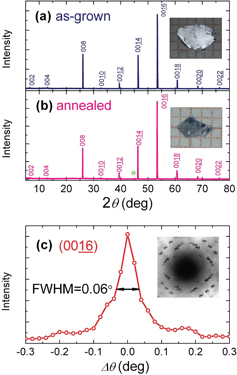
Figure 3. SEM images and typical EDS spectra of a Ba2Ti2Fe2As4O crystal before (a) and after annealing (b). EDS data were collected on the region framed with pink lines.
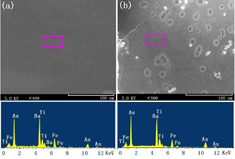
SEM micrographs are shown in the upper panels in figure . The surface of as-grown crystals is much more smooth than that of annealed crystals, which meets the fact that there is tiny impurity on the surface of annealed crystals. EDS data were collected on the region framed with pink line, and the typical spectra are shown in the lower panels of figure . Compositions of as-grown and annealed crystals are listed in table (oxygen content is not displayed because it cannot be accurately determined by EDS). As displayed in the table, the ratio of Ba:Ti:Fe:As is nearly 2:2:2:4 for both specimen, confirming the Ba2Ti2Fe2As4O phase. However, the Ti content is distinctly higher than the Fe content, indicating Ti/Fe substitution in the [Fe2As2] layers. In annealed crystals, the Ti content seems to decrease, which is possibly related to the impurity separated out.
Table 1. Results of the EDS analysis for the specified regions of as-grown and annealed crystals of Ba2Ti2Fe2As4O displayed in figure . The data in parentheses denote the standard deviation (2σ).
Figure shows the electrical resistivity in the ab-plane of as-grown and annealed crystals. As shown, only traces of superconductivity appear in as-grown crystals while for annealed crystals, superconducting transition occurs at Tonsetc ∼ 21.5 K with zero resistance at Tzeroc ∼ 17 K. According to the EDS and XRD analyses, the Ti/Fe substitution in the [Fe2As2] layers destroys the integrity of the Fe-plane and suppresses superconductivity. The appearance of superconductivity can be explained in terms of annealing-stabilized complete Fe-plane. It is in the Fe-plane with little occupancy of Ti that superconductivity occurs. However, in comparison with polycrystalline sample [Citation10], normal-state resistivity of the as-grown crystals shows a semiconductor-like behavior at low temperatures, indicating that there is still some Ti occupying in the Fe-plane, which may serve as magnetic vortex pinning centers (see discussions on figure ). Note that the resistivity upturn at T∗ ∼ 125 K, associated with a CDW/SDW transition in the [Ti2O] sheets, remains unchanged. It means that annealing has no influence on CDW/SDW ordering in the [Ti2O] sheets.
Figure 4. Electrical resistivity in the ab-plane for as-grown (pink squares) and annealed crystals (olive circles) of Ba2Ti2Fe2As4O. The inset zooms in the normalized electrical resistivity at low temperatures.
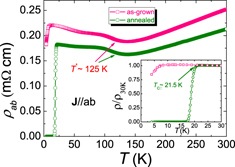
Figure 5. Temperature dependence of magnetic susceptibility for annealed crystals Ba2Ti2Fe2As4O with H∥c (pink dots) and H∥ab (blue dots), respectively. Zero-field cooling (ZFC) and field cooling (FC) processes were employed at field H = 1 Oe. The inset is magnetic susceptibility at a high magnetic field (H = 1 kOe) at high temperatures.
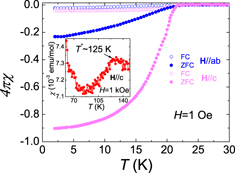
Magnetic properties of these superconducting crystals were then measured on MPMS with the applied field parallel to the c-axis and the ab-plane, respectively. Figure shows temperature dependence of magnetic susceptibility in ZFC and FC modes under H = 1 Oe. Both ZFC and FC curves for the two field orientations (c-axis and ab-plane) drop around 21.5 K, which corresponds with the superconducting transition in the resistivity measurement. The magnetic shielding volume fraction ∼90% defined by 4πχ (ZFC) and magnetic expelling fraction only ∼4.1% by 4πχ (FC) with field applied along the c-axis at 2 K indicate that this compound is a bulk superconductor with flux pinning. This phenomenon is very common in doped iron-based superconductors, such as Co-doped or Ni-doped BaFe2As2 systems [Citation18]. In Ba2Ti2Fe2As4O, as noted above, some Fe-sites are occupied by Ti. These defects caused by Ti/Fe substitution may serve as magnetic vortex pinning centers and lead to a small magnetic expelling fraction.
The inset shows the magnetic susceptibility of annealed crystals at a high magnetic field (H = 1 kOe) with H∥c at high temperatures. One can see that an anomaly occurs around 125 K, which corresponds to the resistivity measurement. For both as-grown and annealed crystals, the anomaly occurs at the same temperature as shown in figure . So this magnetic anomaly is not likely to be associated with the [Fe2As2] layers, which are responsible for superconductivity. Further, the anomaly is also observed in other compounds containing [Ti2O] sheets. In BaTi2As2O the transition occurs at 200 K [Citation19], which is ascribed to a CDW/SDW ordering, while in Ba2Ti2Fe2As4O the transition was suppressed due to charge transfer, which simultaneously causes superconductivity [Citation11]. The CDW/SDW ordering transition around 125 K of single crystal is consistent with that of polycrystalline sample in our previous report, indicating that it is intrinsic. Such a coexistence of CDW/SDW ordering and superconductivity in different blocks has been rarely reported in other superconductors.
4. Conclusions
To summarize, we have successfully grown sizable single crystals of a new iron-based superconductor Ba2Ti2Fe2As4O via a Ba2As3-flux method, and we obtained superconducting crystals by annealing as-grown crystals for a week. The annealing process redistributes the occupancy of Ti within the Fe-plane, which leads to the appearance of superconductivity in [Fe2As2] layers. Another feature of the superconductor is that it contains [Ti2O] sheets which undergo a CDW/SDW transition at 125 K. With such special characteristics, the single crystals of Ba2Ti2Fe2As4O deserve future in-depth investigations by transport measurements and optical and angle-resolved photoemission spectroscopies.
Acknowledgments
This work was supported by Scholarship Award for Excellent Doctoral Student granted by Ministry of Education, NSF of China (contract numbers 90922002 and 11190023), the National Basic Research Program of China (grant number 2010CB923003) and the Fundamental Research Funds for the Central Universities of China.
References
- KamiharaYWatanabeTHiranoMHosonoH 2008 J. Am. Chem. Soc. 130 3296 10.1021/ja800073m
- WangX CLiuQ QLvY XGaoW BYangL XYuR CLiF YJinC Q 2008 Solid State Commun. 148 538 10.1016/j.ssc.2008.09.057
- MarianneRMarcusTDirkJ 2008 Phys. Rev. Lett. 101 107006 10.1103/PhysRevLett.101.107006
- RenZZhuZ WJiangSXuX FTaoQWangCFengC MCaoG HXuZ A 2008 Phys. Rev. B 78 052501 10.1103/PhysRevB.78.052501
- HsuF C et al 2008 Proc. Natl Acad. Sci. USA 105 14262 10.1073/pnas.0807325105
- NiNBud’koS LKreyssigANandiSRustanG EGoldmanA IGuptaSCorbettJ DKracherACanfieldP C 2008 Phys. Rev. B 78 014507 10.1103/PhysRevB.78.014507
- ChenG FLiZDongJLiGHuW ZZhangX DSongX HZhengPWangN LLuoJ L 2008 Phys. Rev. B 78 224512 10.1103/PhysRevB.78.224512
- CanfieldP CBud’koS LNiNYanJ QKracherA 2009 Phys. Rev. B 80 060501 10.1103/PhysRevB.80.060501
- WangX FWuTWuGChenHXieY LYingJ JYanY JLiuR HChenX-H 2009 Phys. Rev. Lett. 102 117005 10.1103/PhysRevLett.102.117005
- SunY LJiangHZhaiH FBaoJ KJiaoW HTaoQShen C YZengY WXuZ ACaoG H 2012 J. Am. Chem. Soc. 134 12893 10.1021/ja304315e
- JiangHSunY LDaiJ HCaoG HCaoC 2012 arXiv:1207.6705v1
- YajimaTNakanoKTakeiriFOnoTHosokoshiYMatsushitaYHesterJKobayashiYKageyamaH 2012 J. Phys. Soc. Japan 81 103706 10.1143/JPSJ.81.103706
- DoanPGoochMTangZ JLorenzBMullerATappJChuP C WGuloyA M 2012 J. Am. Chem. Soc. 134 16520 10.1021/ja3078889
- ZhaiH F et al 2013 Phys. Rev. B 87 100502 10.1103/PhysRevB.87.100502
- YanJ Q et al 2009 Appl. Phys. Lett. 95 222504 10.1063/1.3268435
- YanJ QJensenBDennisK WMcCallumR WLograssoT A 2011 Appl. Phys. Lett. 98 072504 10.1063/1.3555632
- NakajimaMUchidaS IKihouKLeeC HIyoAEisakiH 2012 J. Phys. Soc. Japan 81 104710 10.1143/JPSJ.81.104710
- SunD LLiuYParkJ TLinC T 2009 Supercond. Sci. Technol. 22 105006 10.1088/0953-2048/22/10/105006
- WangX FYanY JYingJ JLiQ JZhangMXuNChenX H 2010 J. Phys.: Condens. Matter 22 075702 10.1088/0953-8984/22/7/075702
